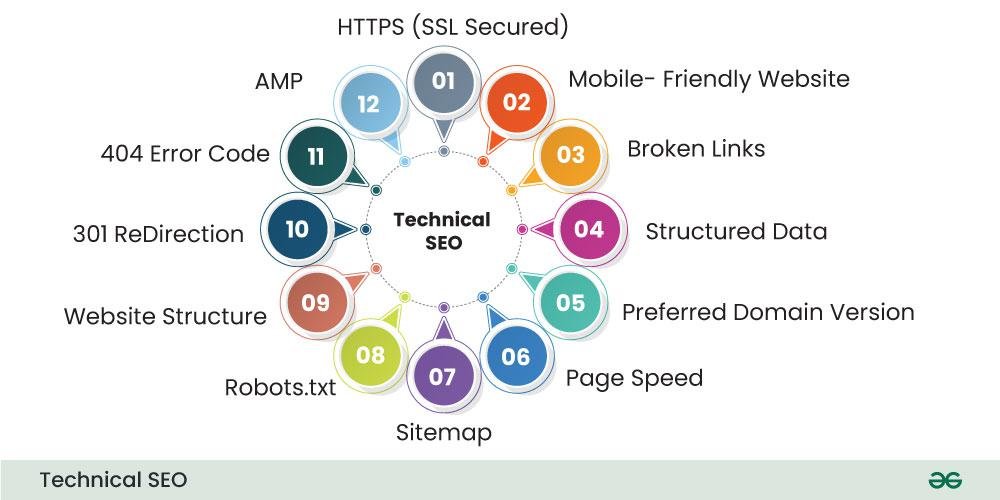
In the world of digital marketing, most discussions about TECHNICAL SEO revolve around keywords, backlinks, and content optimization. While these aspects are crucial, they all rely on one foundational element: technical SEO. If your website isn’t technically sound, search engines won’t be able to properly crawl, index, or rank it—no matter how good your content is.
Technical SEO is the process of improving the architecture of your website so that search engines can more easily access, understand, and index your content. It is the unseen force that
makes you visible online. Let’s look at the key elements of technical SEO and why your website’s success depends on it.
1. Website Crawlability and Indexability
Crawlability
The ability of a search engine to access and examine your website’s information is known as crawlability.If a site can’t be crawled, it won’t be indexed. Ensuring your site is crawlable means checking your robots.txt file and making sure you’re not unintentionally blocking important pages.
Indexability
Once your site is crawled, it must also be indexable. This means the content should be stored in the search engine’s database and ready to appear in search results. Meta tags like “noindex”, canonical tags, and URL parameters can all affect indexability.
Quick Tip: Use tools like Google Search Console to check which pages are indexed and monitor crawl errors.
2. Website Architecture and URL Structure

Flat Site Architecture
A well-organized website with a flat architecture ensures that all important pages are only a few clicks away from the homepage. This enhances the user experience and facilitates content discovery for search engines.Easily find SEO-friendly URLs.
Your URLs should be clean, readable, and descriptive. Avoid random characters and use hyphens to separate words. For example:
bash
CopyEdit
Good: www.example.com/technical-seo-guide
Bad: www.example.com/page?id=123
Consistent and logical URLs contribute to better rankings and easier navigation for both users and bots.
3. Mobile-Friendliness and Responsive Design
With mobile devices driving the majority of web traffic, mobile optimization is no longer optional. Google employs mobile-first indexing, which means that it ranks and indexes websites primarily using their mobile versions.
A responsive design automatically adjusts to different screen sizes, improving user experience To assess how well your website works on mobile devices, use Google’s Mobile-Friendly Test.
4. Site Speed and Performance

Why Speed Matters
Site speed is a confirmed ranking factor . Higher bounce rates and a poor user experience are the results of a slow website. Google states that pages should load in less than three seconds.
How to Improve Speed
- Compress images without losing quality
- Enable browser caching
- Minify CSS, JavaScript, and HTML files
- Use a Content Delivery Network (CDN) to serve your site faster across regions
Tools like PageSpeed Insights or GTmetrix can help identify speed-related issues.
5. Secure Websites: HTTPS Protocol
Security is a top priority for search engines. That’s why switching from HTTP to HTTPS (secured by an SSL certificate) is essential. HTTPS websites:
- Rank slightly better on Google
- Are more trustworthy to users
- Provide data protection
Most browsers now display a “Not Secure” warning for non-HTTPS sites, which can deter visitors.
6. XML Sitemap Optimization
An XML sitemap acts like a roadmap for search engines, guiding them to your most important pages. It helps:
- Speed up the indexing of new or updated content
- Highlight pages that may be otherwise hard to reach
Best practices:
- Submit your sitemap in Google Search Console
- Exclude duplicate or irrelevant URLs
- Keep it updated automatically with site changes
7. Structured Data and Schema Markup
Schema markup, also known as structured data, aids search engines in comprehending the context of your content.It enhances your search listings with rich snippets like star ratings, FAQs, event dates, and more.
For example, a recipe blog using schema might show cooking time, ingredients, and star ratings directly in search results, increasing click-through rates.
Tools like Google’s Rich Results Test and Schema.org can help you implement and validate structured data.
8. Canonical Tags and Duplicate Content
Duplicate content could confuse search engines and hurt your rankings.When there are duplicate or similar pages, canonical tags inform search engines which version of the page is the “master” version.
Example:
Use a canonical tag to direct all variations of a product that is listed under several categories to the main URL. This avoids duplicate content penalties and consolidates ranking power.
9. Fixing Broken Links and Redirects
Broken links harm both user experience and SEO. Regularly audit your site to:
- Fix 404 errors (Page Not Found)
- Ensure all redirects use 301 (permanent) instead of 302 (temporary)
- Avoid redirect chains and loops
Tools like Screaming Frog SEO Spider or Ahrefs Site Audit are excellent for identifying these issues.
10. Core Web Vitals
- Google introduced Core Web Vitals, a ranking criterion that gives priority to practical user experience metrics:
- LCP (Largest Contentful Paint): Measures load speed
- FID (First Input Delay): Measures interactivity
- CLS (Cumulative Layout Shift): Measures visual stability
Improving these metrics requires collaboration between SEO professionals and developers. Tools like Google Search Console and Lighthouse can help track and improve Core Web Vitals performance.
Conclusion: The Foundation of TECHNICAL SEO Success

Your entire SEO strategy is founded on the foundation of technical SEO. It ensures that your beautifully written content and keyword-rich pages are discoverable, indexable, and valuable in the eyes of search engines. It may not be flashy, but without it, your SEO efforts can fall flat.
If you want long-term success in organic search, investing time and resources into technical SEO is non-negotiable. By ensuring a technically optimized website, you create a better experience for users and a clear path for search engines—leading to improved rankings, traffic, and business growth.



